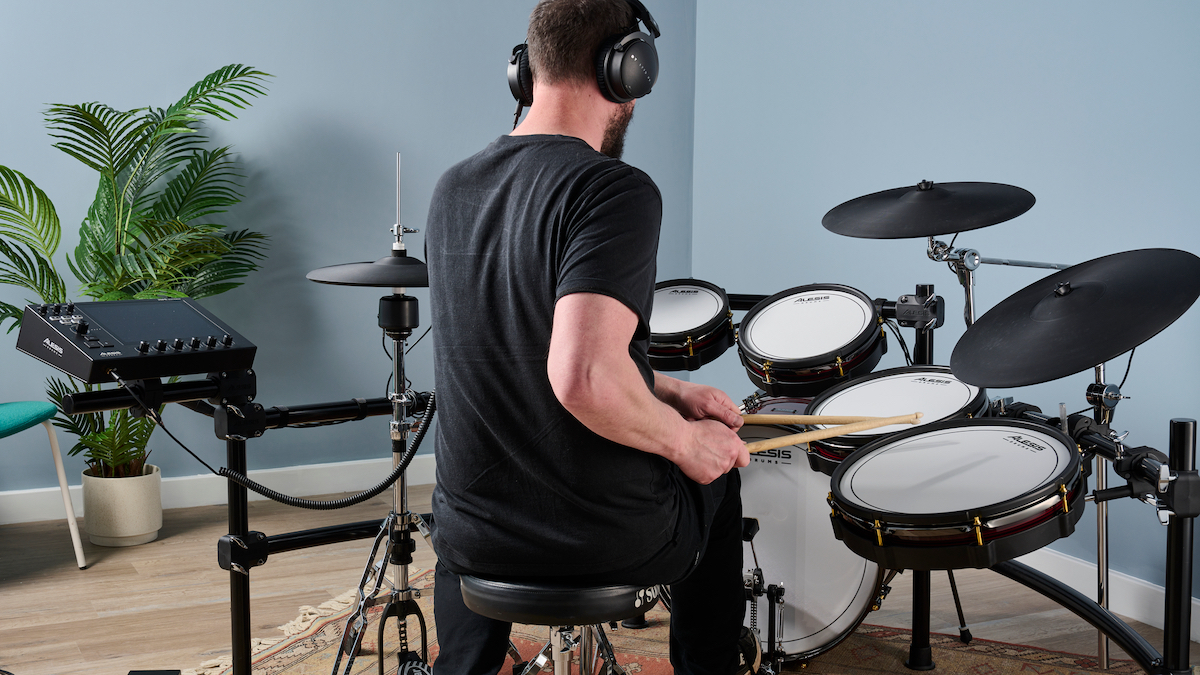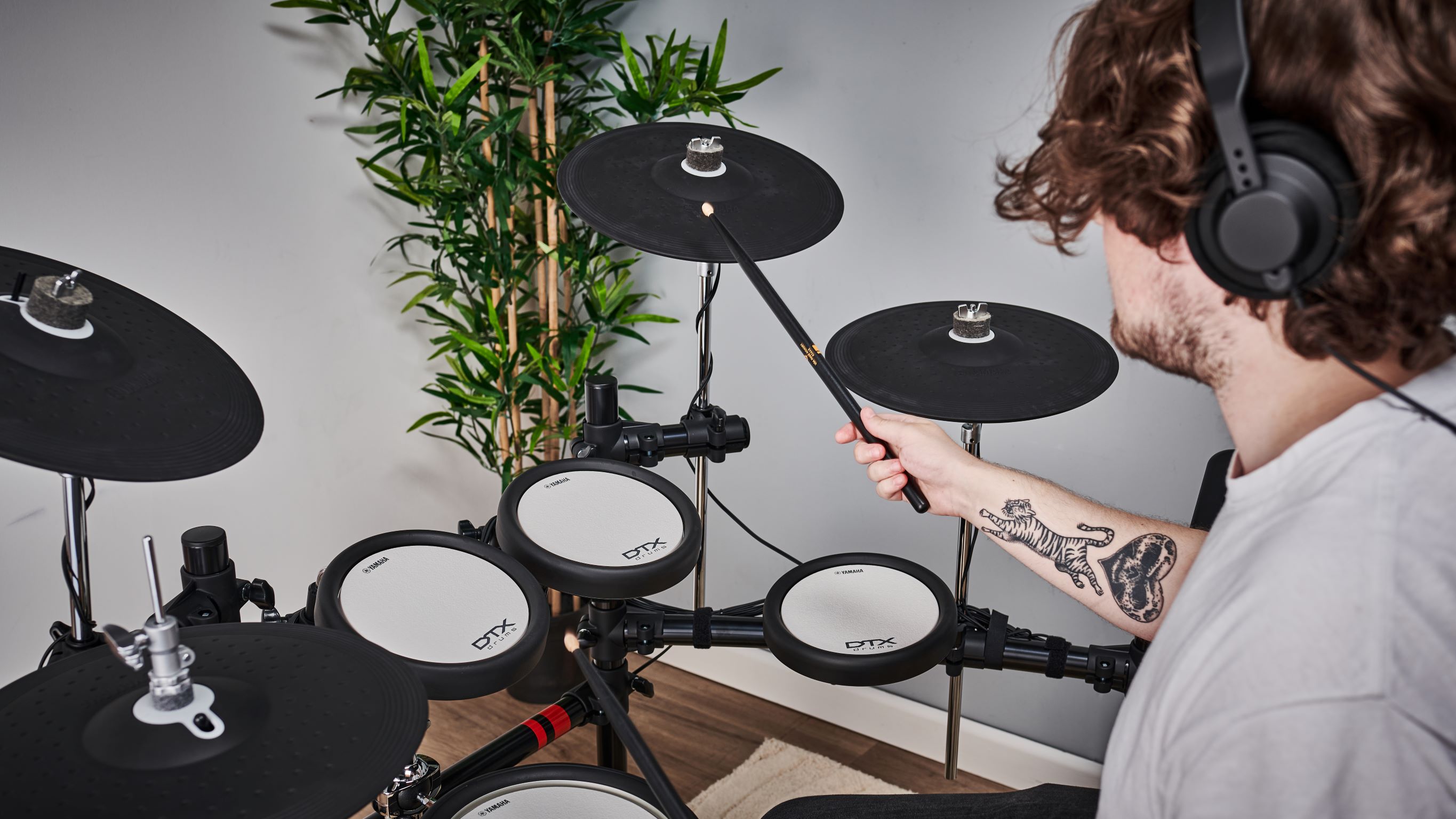10 reasons to buy an electronic drum set
From quieter practice to flexible sounds, here's why an electronic drum kit is the perfect alternative to acoustic drums

Learning and playing the drums is not without its challenges. A fully-stocked acoustic drum kit is large, loud, and can be expensive. Nowadays, however, the technology behind electronic drum sets (aka 'e-kits') has progressed to such a level that they’re no longer a distant relation. Modern e-kits, from beginner electronic drum sets to top-end rigs deliver a superb playing experience, come stocked with plenty of different sounds, and can be safely stowed away when they’re not in use.
In this guide, we’ll outline some of the key reasons an electronic drum set is a worthwhile investment. We’ll explain the types of situations in which they excel, and highlight some of the benefits you’ll find from going electric.
So, if you've been on the fence about whether to take the plunge, this expert guide should help you decide.
1. Volume (or lack of it)
Chief among the barriers when it comes to learning drums is the sheer, unavoidable fact that they are loud. Extremely loud. Acoustic drums don’t have a volume control, after all. If you’re living out in the countryside, with no neighbours to bother, then you’re in luck. Halfway up a block of flats, not so much. Electronic kits offer up a perfect solution here, in that they can be played using headphones, so the only noise your neighbours will hear, if anything, is the gentle tap of your drumsticks and pedals hitting the pads, and even then there are ways to help minimise the acoustic noise of an electronic kit. We go into more detail about how to make an electronic drum set quieter in this feature.
If you do find yourself in a situation where playing louder is possible, then your electronic kit will simply connect up to a set of monitor speakers, dedicated drum amplifier or PA system. More on this later…
2. Variety of sounds
When it comes to playing and practicing music, you can be influenced by many things. It’s also very likely that, as a drummer, you’ll be getting to grips with multiple styles of playing along your journey. With electronic drum sets, you can switch the kit’s sounds in an instant, taking you from vintage jazz to stadium rock to an 808-style electronic kit at the touch of a button.
Using an electronic kit in this way can make your practice and play-along sessions way more authentic and fun. So, if you are partial to a bit of genre-jumping, an electronic drum set might be the best option for you.
Want all the hottest music and gear news, reviews, deals, features and more, direct to your inbox? Sign up here.

3. Playability
In the early days of electronic drums, the pads were rigid and unforgiving, causing fatiguing vibrations to run into your hands. They also created a stick rebound that was more akin to hitting your kitchen table than striking an acoustic drum. These days though, it’s an entirely different story. While the most affordable kits still use rubber pads, they’re a lot more enjoyable to play.
Step up in price, and you’ll be rewarded with mesh heads which are tuneable, acoustically quieter in the room and are the closest thing you can get to the feel of a traditional drum head. This is important from a technical standpoint too, as many rudiments rely on the ability to play dynamically, and control the way the stick rebounds. Modern electronic sets give you all of this, meaning you can transfer your skills between electronic and acoustic kits.
4. Practice
As with any instrument, the more you play it, the better you’ll get. Most electronic drum sets feature built-in practice tools to help you develop your skills. This could be as simple as a metronome, or as complex as dedicated coaching and lessons designed to help you tighten up your chops. These features aren’t limited to beginners either; even the best players dedicate time to doing those repetitive exercises that keep them sharp.
It’s also common to find drum modules with an audio input socket, or increasingly, Bluetooth, so you can hook up a smartphone or tablet and play along to your favourite songs or backing tracks with your kit blended in perfectly.
5. Portability and space
In an ideal world, a drummer would have a dedicated space in which they can leave their kit set up and ready to go at a moment’s notice. Of course, for a large number of players, this isn’t always possible. Acoustic drum sets are large and awkwardly shaped, so if you don’t have a large space in which to store them, you may find you have to rely on precariously stacked flight cases when you’re not using it, which is never ideal.
With electronic kits, particularly at the low-to-mid range, portability and easy storage is a key selling feature. Many kits can be quickly and easily folded down and stored away without too much hassle.

6. You can expand the sounds…
A major benefit to using electronic drum sets is the ability to connect them up to external devices. They do this using MIDI, either via dedicated 5-pin MIDI cables or via a USB connection. This means you can play other MIDI-equipped instruments from your kit, but the most likely scenario is hooking your kit up to a computer. From here you can play samples, loops or entire tracks from your pads, but even more excitingly, you can gain access to completely new kits.
We’re particularly fond of Toontrack’s EZ Drummer, which has an amazing – and expandable – library of drum kits recorded in top-flight studios, then processed to give you some seriously impressive sounds. For recording, this is a game-changer. No more messing around with microphones and room acoustics. You simply record your part as a MIDI, then tell it what sound to play.
7. You can also expand the pads
Choice is one of the biggest leaps forward across any musical instrument these days, but let’s say you want to add another drum to your acoustic kit - there are still a number of considerations. First you need to find the right size, in the same series and (ideally) finish as the rest of your kit. Add-on drums can be expensive when purchased in this way, as can additional cymbals.
With an electronic kit, it’s just a case of making sure your module has a spare pad/trigger input (most do) and buying an affordable additional pad like the ones that came with your kit. Often, electronic drum companies use the same pads across different kits, making them widely-available. There are also plenty of third-party pads that can work more universally across brands. Once you’ve got it, the pad can be assigned and reassigned to play any sound you want from your module.
8. Price
It’s worth highlighting price as a factor in choosing an electronic drum kit. When it comes to acoustic drums, as with any instrument, there are cheaper entry-level models which are easy to outgrow. Then, as you progress, you’ll find playing drums can be an expensive pastime when you factor in upgrades, improvements and consumables. With electronic drum sets, you get the full functionality from the day you buy the kit, with your only ongoing purchase likely to be drumsticks, or a bass drum pedal upgrade for the foreseeable future.

9. Recording
As outlined earlier, recording with an electronic drum kit is a match made in heaven. Much as many guitarists now look to virtual amp simulations, drummers who combine a decent electronic kit with an arsenal of virtual instruments find they have access to pretty much any drum sound they want.
The main thing you gain from this method is control. You’re not reliant on the room you record in, you don’t need stacks of drum kit microphones, and you have a mind-boggling array of tools to fix, alter and amend your recordings afterwards. From tweaking micro-timings of specific hits, through to applying effects and polish to the audio. It’s all done with a few simple clicks of a mouse.
10. You’ll become a more versatile musician
Ok, so not everyone wants to pursue drumming beyond playing for enjoyment and possibly starting a band. But even as a hobbyist, having a decent grasp of how electronics work within a drum kit is a valuable skill. You can bring new sonic landscapes to your band, make your covers more authentic and inject additional creativity to a standard four-piece if you understand how to incorporate samples, click tracks and electronic sounds. Take it slow, learn the terminology as you go and you’ll find that its a lot simpler than it is sometimes made out to be!
Chris Corfield is a journalist with over 12 years of experience writing for some of the music world's biggest brands including Orange Amplification, MusicRadar, Guitar World, Total Guitar and Dawsons Music. Chris loves getting nerdy about everything from guitar and bass gear, to synths, microphones, DJ gear and music production hardware.
